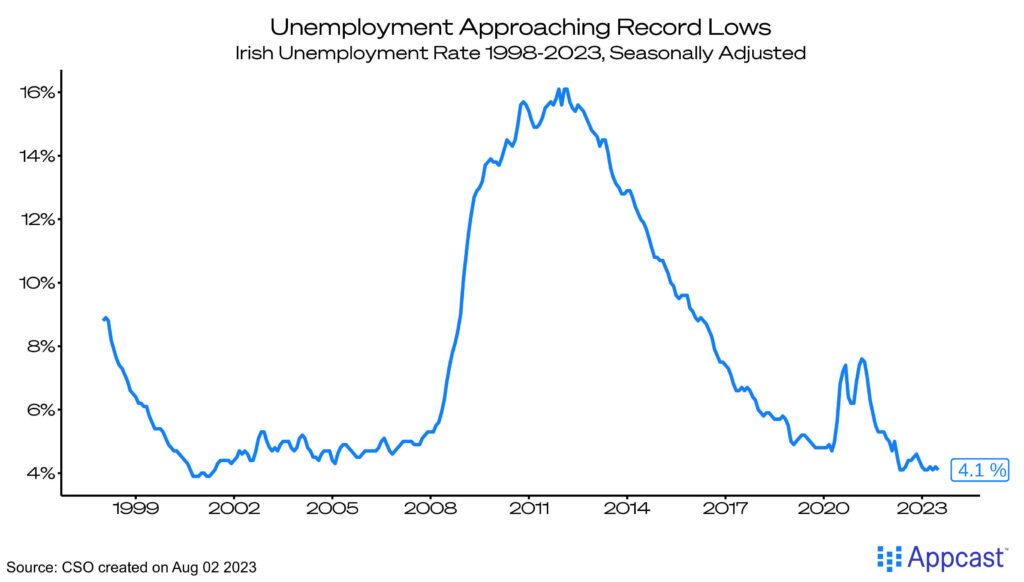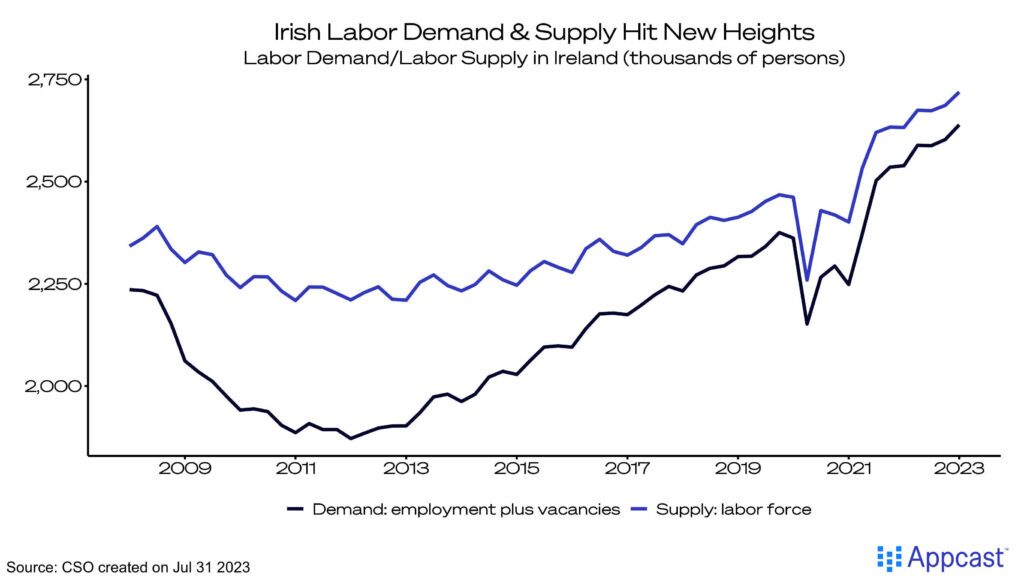Employment in Ireland
Following the Global Financial Crisis and the collapse of the Celtic Tiger in Ireland, unemployment in the country reached a high of 16.1% in December 2011. Over the next decade, the economy recovered remarkably quickly, and the Irish returned to work in droves. By January 2020, the unemployment rate had receded to 4.8%. During the pandemic, joblessness surged, but since then, Irish employment trends have returned to an impressive trajectory. The latest unemployment rate of 4.1% in July 2023 certainly indicates that the Irish economy is operating at capacity. The Irish labor market is booming.

New Highs in Demand for Irish Labor
As the unemployment data suggests, demand for labor in Ireland has entered unchartered territory. In Q1 2023 Ireland passed 2.6 million employed persons, far above the pre-crash high of 2.25 million in 2007. The number of job vacancies in the country is also still elevated from pre-pandemic levels. The demand for labor, the sum of employment and vacancies, has never been as high as it currently is in Ireland.

The most recent employment statistics may come as a surprise to many. Sentiment in the country earlier this year seemed to indicate that potential job losses in the information and communication sector (better known as the tech sector) could have had a profound effect on employment. Given the presence of many multinational (read American) tech companies in Ireland who had announced intentions to restructure, including the likes of Google and Meta, this seemed a reasonable assumption. Ireland is not only hugely reliant on these companies for tax revenues, but also jobs – 5.2% of the local workforce is employed in the information and communication sector, compared to the EU average of 3.7%.
In the end though, the employment contraction in the sector was only minimal. The Central Bank of Ireland estimated 2,300 tech jobs were cut at the beginning of 2023 and the total number employed in ICT only dropped by less than 1%, with minimal impact on nationwide employment. This surprise was largely akin to what happened in the United States, where job cuts were significantly larger scale (surpassing 100,000 between January and February 2023) but overall demand for workers across the information sector was similarly only minorly affected.

It is fascinating to see how closely Ireland’s demand follows local demand in the U.S., really highlighting the influence of U.S. companies in Ireland. The American Chamber of Commerce in Ireland estimates that U.S. companies employed 376,000 people in Ireland either directly or indirectly in 2022 – about 15% of jobs in the country. So, while labor markets remain tight in the U.S., it contributes directly to demand for labor in Ireland. However, Irish employment is notably increasing at a rate even faster than the U.S., both in the ICT sector and across the economy. Over the 3 years following January 2020, the total number of employees increased by 12% in Ireland versus 2% in the U.S. While both nations undoubtedly have high demand, it seems the Irish market is more fit to fulfil this demand. Employers are finding it easier to meet their talent needs in Ireland because the country enjoys a relatively stronger supply of workers.
A Labor Force that Can Meet High Demand
The Irish labor force is uniquely equipped to cater to growing global demand for labor. The number of persons participating in the labor force in Ireland has hit record levels recently (see labor supply and demand chart) and there are a few interesting demographical factors contributing to this.
Firstly, Ireland is finally catching up with the rest of the EU when it comes to female labor force participation. Historically low thanks to the legacy of a strict marriage bar and conservative values, the number of women who are working or searching for work in Ireland has seen a rapid rise since COVID-19 closed the country down.

Secondly, the long history of high Irish fertility rates means they are now the 2nd youngest population in Europe, with a median age of 38.8 years.
Also, the Irish population is now one of the most educated in Europe. After Luxembourg, Ireland has the 2nd highest share of its population aged 15-64 with a third-level degree in the EU. Interestingly, Ireland has taken huge strides in this area since 1992, when over half of the working-age population had not even completed higher second-level education. This highly skilled, young workforce is proving well placed to fill supply gaps in international labor markets.

Finally, and most pertinently, Ireland has experienced positive net migration over the last few years. Irish people have a long tradition of emigration, so as the national dynamic shifts to net positive migration, it hugely boosts the labor force. The particularly high immigration in 2022 was also helped by an influx of Ukrainian refugees relocating due to the war. Net migration was the greatest contributor to Irish labor force growth in 2022, adding 71% of new workers.

Conclusion
Tight global labor markets are like rocket fuel for Irish labor demand. So far, the Irish work force has been able to grow to meet this demand. As economic theory explains, when both supply and demand simultaneously increase, output grows with them. GDP growth of 12% in the nation during 2022 would certainly support this conclusion but, in the special case of Ireland GDP should not be taken too seriously. However, Modified Domestic Demand, a more relevant figure, was also estimated to have increased by 8.2% over the year. Ireland’s economy is growing as its labor market booms.








